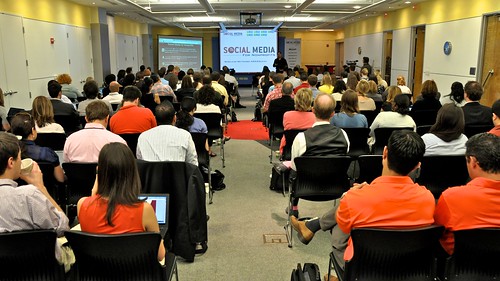Today’s Social Media for Nonprofits conference in Washington, DC featured a stellar list of speakers and local voices. The purpose of the conference was practical tips, tools and approaches to be more effective online with social media.
Michael Smith, Case Foundation
Michael Smith, Case Foundation’s Sr. VP for Social Innovation, said Case has three Twitter accounts with more than 380,000 followers, but it is just moving forward with Facebook, and is blogging every day. They even have a blog series called Dress to Give, using fashion to drive online fundraising.
Smith talked about contests Case uses to drive people into their blog and Facebook page (apparently, the iPad is mana). Case will now limit its blog to once a week as result of analyzing their data. They use metrics to drive an evolving strategy, and are moving to more of a curation model on their social networks. They are also using video, and supporting numerous technology efforts.
Smith also talked about Crowdfunding, and the importance to create win-wins for everyone. Have folks give $10 so you can win a matching grant. He was not bullish on “vote for me” contests. Case Foundation has invested in various platforms that have raised more than $500 million to date.
Katya Andresen, Network for Good
Katya Andresen, Chief Strategy Officer at Network for Good, did a tour of the brain. She says people are wired for empathy, and we are naturally altruistic. We have a positive physical reaction to make a difference. Giving makes people happy. Recurring giving makes people very happy. The #1 reason why people are not giving is because we are talking to them in the wrong way via email and on Facebook, she said.
Katya emphasized the importance of telling a great stories. People have an expectation that they will have a deeply human experience on Facebook. We need to cater to that. Emotional impact is what compels people to give.
People give the more they believe their friends are in pain (marathons, etc.). They need online voices to have a heartbeat and care, a personal connection. “Your social media presence must have a pulse,” said Katya. Make one-to-one ties that are tight.
You can’t change the emotional, personal nature of fundraising. This is the way people are. Ignore these truths at your own peril. There’s no nobility in a bullhorn to the masses online for nonprofits. We’re saving lives, said Katya.
Sarah Koch, Causes
Causes‘ Sarah Koch talked about what community means: It is more than a place where there are people like you, too. Community is about engagement, and people need real connections and dialogue. You need to cultivate real communities, and give to them so you can get something from them, said Sarah. How can you give labor and attention to your community?
Give people what they want, including what they are donating to, why, and how will it matter. Provide the content to inspire them. Why is their $25 important? Give them a reason to give now, tell their friends and get them inspired. This is through storytelling via personal connections, said Sarah, referencing Project Night Night as an example.
Dionna Humphrey, Greenpeace
Greenpeace’s Dionna Humphrey says people on Facebook, Twitter and other communities are different than the folks on email lists. She noted Facebook users are more likely to click through than another social network. Greenpeace uses social networks separately or to augment their email efforts.
Mattel was targeted in a Greenpeace campaign that involved a fake Ken doll and Twitter. Ken breaks up with Barbie because she is deforesting rain forests. The break was public and had email, Twitter, in person activism, Facebook and a full international push. It used the #deforestation hashtag, which is the best way to drive a buzz said Humphrey.
Peter Panepento, Philanthropy.com
Philanthropy.com‘s Managing Editor Peter Panepento says small non-sexy nonprofits aren’t very successful at fundraising. They are challenged by time limitations, and an almost dire need for support. New tools like Google+ are best left experimented with/by large nonprofits, instead of small NPOs who will be hurting themselves by doing it.
Peter cited San Diego Hospice’s work on Facebook and Twitter as an ideal use of social media. Dozens of people write on their Facebook page every week thanking them, something that advertising can’t buy. The engagement has paid off with results and more followers. Social media has boosted their traffic by 90 percent. 3,500 Twitter followers is an amazing number for a small nonprofit. Other examples cited by Peter include Estrella Rosenberg and Miriam’s Kitchen.
